PENGEMBARAAN SEORANG INSAN
Tuesday, April 7, 2015
Monday, March 30, 2015
HOTEL PELANGI, MUAR, JOHOR
Ingin mencari tempat menginap ?? atau ingin mengadakan majlis, mesyuarat, perjumpaan, majlis perkahwinan dan sebagainya tetapi tiada tempat :(
~Mungkin ini penyelesaiannya~
HOTEL YANG DIMILIKI 100% OLEH ORANG MELAYU BUMIPUTERA....:)
Sedikit info tentang HOTEL PELANGI ~
- Terletak di tengah- tengah BANDAR MUAR ( Bandar Maharani ).
- Dikelilingi oleh kedai- kedai yang pelbagai dan pusat membeli- belah.
- Berdekatan pusat hiburan dan Sungai Muar.
- Bilik yang selesa dan berpatutan.
- Mempunyai dewan dan juga banquet yang boleh disewa dengan harga yang berpatutan.
Fasiliti- fasiliti hotel :



Sunday, May 18, 2014
GREAT PYRAMID OF GIZA
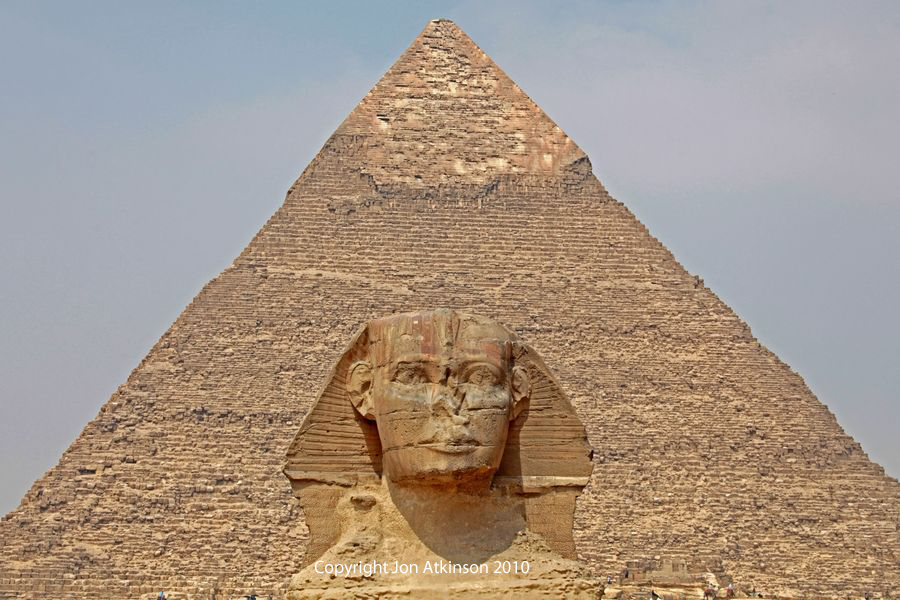
The most amazing pyramid- Pyramid of Giza

Wonderful sunset !!
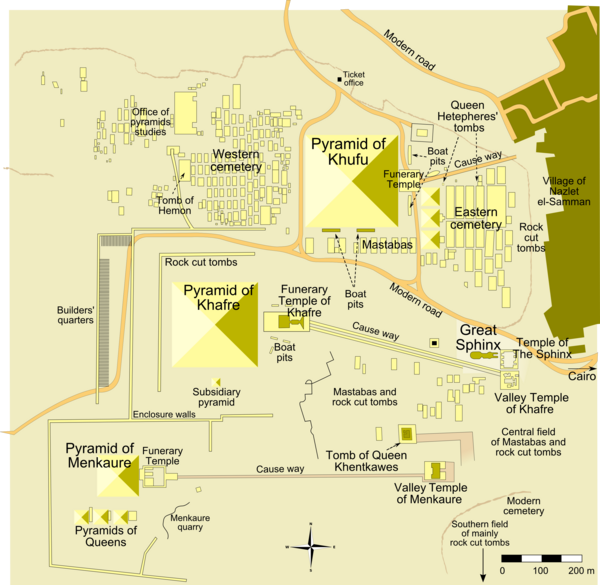
The map of Pyramid Giza
Location : Great Pyramid Of Giza, Giza, Egypt.
The Great Pyramid of Giza (also known as the Pyramid of Khufu or the Pyramid of Cheops) is
the oldest and largest of the three pyramids in the Giza Necropolis bordering what is
now El Giza, Egypt. It is the oldest
of the Seven Wonders of the Ancient World, and the only one
to remain largely intact. Based on a mark in an interior chamber naming
the work gang and a reference to fourth dynasty Egyptian Pharaoh Khufu, Egyptologists believe that the
pyramid was built as a tomb over a 10 to 20-year period concluding around 2560
BC. Initially at 146.5 metres, the Great Pyramid was the tallest man-made structure in the world for
over 3,800 years. Originally, the Great Pyramid was covered by casing stones
that formed a smooth outer surface, what is seen today is the underlying core
structure. Some of the casing stones that once covered the structure can still
be seen around the base. There have been varying scientific and alternative
theories about the Great Pyramid's construction techniques. Most accepted
construction hypotheses are based on the idea that it was built by moving huge
stones from a quarry and dragging and
lifting them into place.
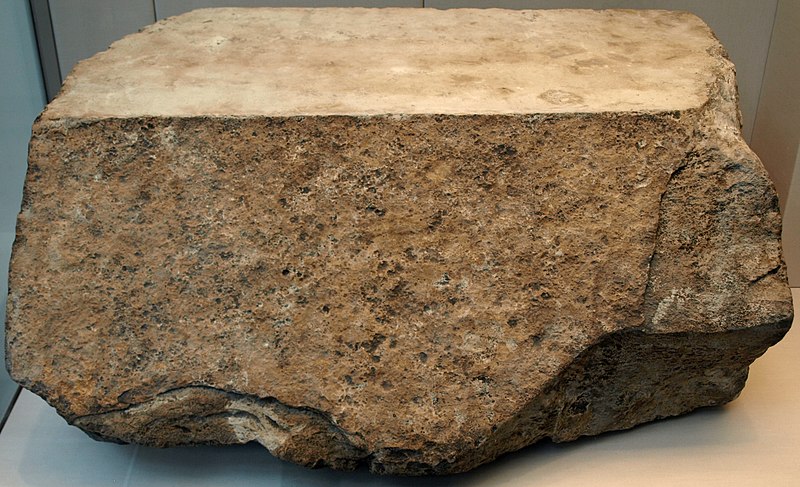
Casing stone for the Great Pyramid
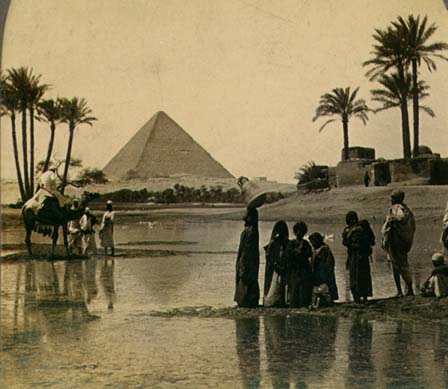
Great Pyramid of Giza in 19th century
The
Great Pyramid consists of an estimated 2.3 million limestone blocks which
most believe to have been transported from nearby quarries. The Tura
limestone used for the casing was quarried across the river. The largest
granite stones in the pyramid, found in the "King's" chamber, weigh
25 to 80 tonnes and were
transported from Aswan, more than
800 km away. Traditionally, ancient Egyptians cut stone blocks by
hammering wooden wedges into the stone which were then soaked with water. As
the water was absorbed, the wedges expanded, causing the rock to crack. Once
they were cut, they were carried by boat either up or down the Nile River to the pyramid. It
is estimated that 5.5 million tonnes of limestone, 8,000 tonnes of granite
(imported from Aswan), and 500,000 tonnes of mortar were used in the
construction of the Great Pyramid.

Diagram of the interior structure of the Great Pyramid of Giza
The
original entrance to the Great Pyramid is 17 metres vertically above ground
level and 7.29 metres east of the center line of the pyramid. After 105.23
metres, the passage becomes level and continues for an additional 8.84 metres to
the lower Chamber, which appears not to have been finished. There is a
continuation of the horizontal passage in the south wall of the lower chamber,
there is also a pit dug in the floor of the chamber. At the start of the Grand
Gallery on the right-hand side there is a hole cut in the wall, (and now
blocked by chicken wire). This is the start of a vertical shaft which follows
an irregular path through the masonry of the pyramid to join the Descending
Passage. Also at the start of the Grand Gallery there is a Horizontal Passage
leading to the "Queen's Chamber". The passage is 1.1 metre high for
most of its length, but near the chamber there is a step in the floor, after
which the passage is 1.73 metres high.
ANGEL FALLS
 Most incredible waterfall !!
Most incredible waterfall !!
Beautiful waterfall 

 Map of Angle Falls
Map of Angle Falls
Location : Auyantepui, Canaima National Park, Bolivar State, Venezuela.

Angel Falls is the world's highest uninterrupted waterfall, with a height of
979 metres and a plunge of 807 metres. The waterfall drops over the
edge of the Auyantepui mountain in the Canaima National Park, a UNESCO World Heritage site in the Gran Sabana region of Bolívar State. The height figure 979 metres mostly
consists of the main plunge but also includes about 400 metres of sloped
cascades and rapids below the drop and
a 30 metres high plunge downstream of the talus rapids.

Image from the top of waterfall
Angel
Falls is one of Venezuela's top tourist attractions, though a trip to the falls
is a complicated affair. The falls are located in an isolated jungle. A flight
from Puerto Ordaz or Ciudad Bolívar is required to
reach Canaima camp, the starting point for river trips to the base of the
falls. River trips generally take place from June to December, when the rivers
are deep enough for the wooden curiaras used by the Pemon guides. During the
dry season (December to March) there is less water seen than in the other
months.
Angel
Falls also inspired the setting of the Disney animated film Up (2009) although, in the film, the
location was called Paradise Falls instead of Angel Falls. It also makes a
small appearance in the Disney film Dinosaur, as well as the 1990 film Arachnophobia.
THE WAVE

Incredible place - The Wave

The Wave

Map of The Wave
Location : Coconino County, Arizona, U.S.A.
The Wave is a sandstone rock formation
located in the United States of America near the Arizona-Utah border, on the
slopes of the Coyote Buttes, in the Paria Canyon-Vermilion Cliffs
Wilderness, on the Colorado Plateau. It is famous
among hikers and photographers for its colorful, undulating forms, and the
rugged, trackless hike required to reach it. Consists of intersecting
U-shaped troughs that have been eroded into Navajo Sandstone of Jurassic age. The two major
troughs, which comprise this rock formation, are 62 feet wide by 118 feet long
and 7 feet wide by 52 feet long.
The
Wave exposes large-scale, sets of cross-bedded eolian sandstone composed
of rhythmic and cyclic alternating grain flow and wind ripple laminae. The rhythmic and cyclic alternating laminae represent
periodic changes in the prevailing winds during the Jurassic as huge sand dunes
migrated across a sandy desert. The thin ridges and ribbing seen within The
Wave are the result of the differential erosion of rhythmic and cyclic
alternating grain flow and wind ripple laminae within the Navajo Sandstone. These
laminae have differing resistance to erosion as they have been differentially
cemented according to variations in the grain size of the sand composing them.
The soft sandstone, including the ridges and ribbing, of The Wave is fragile.
As a result, persons must walk carefully to avoid breaking the small ridges.
Tourists
can go to The Wave by the any vehicles at the good weather. During and after a
storm the road may be impassable, even with a four-wheel-drive vehicle. Wire
Pass Trailhead includes a wide parking lot with restrooms, but no water. It is
also accessible from the Arizona side by taking U.S. Highway 89A from Jacob Lake on the Kaibab Plateau toward Navajo Bridge, turning north onto the House Rock Valley Road,
after descending from the Kaibab. This is a longer access route over dirt road
than from the Utah side. From the Wire Pass Trailhead, The Wave can be
reached by hiking approximately 4.8 km across open desert, making the
round-trip to and from The Wave nearly 9.7 km climbing about
110 metres in altitude.
PLITVICE LAKE
Incredible view from the top 

 Beautiful Lake
Beautiful Lake
Map of Plitvice Lake 

Location : Plitvice Lakes National Park, Croatia.
Plitvice Lakes National Park is the oldest national park in Southeast Europe and the largest
national park in Croatia. The national park
was founded in 1949 and is situated in the mountainous karst area of central
Croatia, at the border to Bosnia and Herzegovina. The important
north-south road connection, which passes through the national park area,
connects the Croatian inland with the Adriatic coastal region.
In 1979, Plitvice Lakes National Park was added to the UNESCO World Heritage register among the first natural sites worldwide. Each year, more than 1,200,000
visitors are recorded.
The
national park is world famous for its lakes arranged in cascades. Currently, 16
lakes can be seen from the surface. These
lakes are a result of the confluence of several small rivers and subterranean
karst rivers. The lakes are all interconnected and follow the water flow.
The sixteen lakes are separated into an upper and lower cluster formed by runoff from the mountains, descending from an altitude of 636 to
503 meter over a distance of some eight km, aligned in a south-north
direction. The lakes collectively cover an area of about two square kilometres,
with the water exiting from the lowest lake forming the Korana River.


The lady's-slipper orchid Brown bear
The
Plitvice Lakes national park is heavily forested, mainly with beech, spruce, and fir trees, and
features a mixture of Alpine and Mediterranean vegetation. Scientists
have so far listed 1,267 different plants out of 109 species that can be found
within the area of the national park. The
area of the national park also is home to an extremely wide variety of animal
and bird species. Rare fauna such as the European brown bear, wolf, eagle, owl, lynx, wild cat and capercaillie can be found there, along with many more common species.
As regards bird species, the Plitvice Lakes rank third among other Croatian
national parks. Up to now, 157 species have been counted, of which 70 have been
recorded as breeding there.
MALDIVES
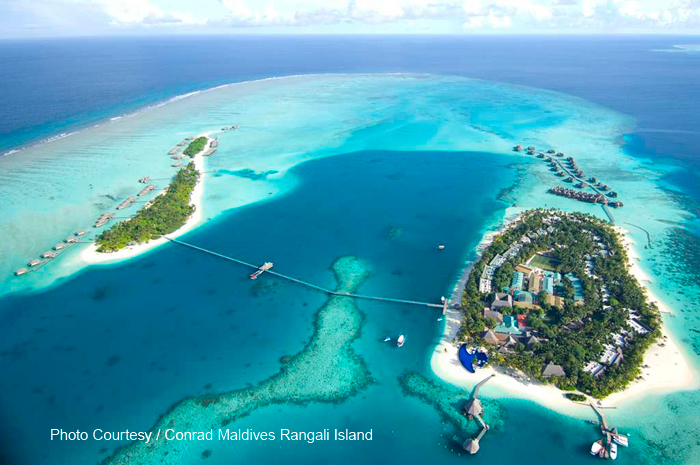
Maldives from the top

Maldives beautiful beach

Night in Maldives
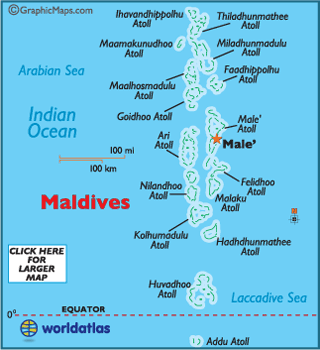
Map of Maldives
Location : Male, Republic of the Maldives.
Maldives, officially
the Republic of the Maldives and also referred to as the Maldive Islands, is
an island nation in the Indian Ocean-Arabian Sea area, consisting
of a double chain of twenty-six atolls, oriented north-south, that lie between Minicoy Island (the southernmost part of Lakshadweep, India) and the Chagos Archipelago. The chains stand in the Laccadive Sea, about 700 kilometres south-west of Sri Lanka and 400 kilometres south-west of India. The Maldives
is the smallest Asian country in both population
and land area. With an average ground level elevation of 1.5 metres above sea
level, it is the planet's lowest country. It is also the country
with the lowest natural highest point in the world, at
2.4 metres. Forecasts
predicting future inundation of the Maldives due to rising sea levels are of great
concern to its people.

Oldest Mosque in Maldives (Hukuru miskiy)
Most
of the Maldives communities are Muslim. The famous Moroccan traveller Ibn Batutta, who visited the Maldives in the 14th century,
wrote how a Moroccan, one Abu Barakat the Berber, was believed to have been responsible for spreading Islam
in the islands. Even though this report has been contested in later sources, it
does explain some crucial aspects of Maldivian culture. For instance, historically
Arabic has been the prime language of administration there, instead of the
Persian and Urdu languages used in the nearby Muslim states. Another link to
North Africa was the Maliki school of
jurisprudence, used throughout most of North-Africa, which was the official one
in the Maldives until the 17th century.


Oriental Sweetlips Sea Hibiscus
Maldives consists of 1,192 coral islands grouped in a
double chain of 26 atolls, along the north-south direction, spread over
roughly 90,000 square kilometres, making this one of the world's most dispersed
countries. Maldives
waters are home to several ecosystems, but are most noted for their variety of
colourful coral reefs,
home to 1100 species of fish, 5 species of sea turtles,
21 species of whales and dolphins, 187 species of corals, 400 species of
molluscs, and 83 species of echinoderms. Many crustacean species are there as
well 120 copepod, 15 amphipod as well as over 145 crab and 48 shrimp species.

Resort in Maldives
The Maldives remained largely unknown to
tourists until the early 1970s. Only 185 islands are home to its 300,000
inhabitants. The other islands are used entirely for economic purposes, of
which tourism and agriculture are the most dominant. Tourism accounts for 28%
of the GDP and more than 60% of the Maldives' foreign exchange receipts. Over
90% of government tax revenue comes from import duties and tourism-related
taxes. The development of tourism fostered the overall growth of the country's economy. It
created direct and indirect employment and income generation opportunities in
other related industries. The first tourist resorts were opened in 1972 with
Bandos island resort and Kurumba Village, which transformed the Maldives economy.
The number of resorts increased from 2 to 92 between 1972 and 2007. As of 2007,
over 8,380,000 tourists had visited Maldives. Tourism was also the
country's biggest foreign currency earner and the single largest contributor to
the GDP.
Subscribe to:
Posts (Atom)




